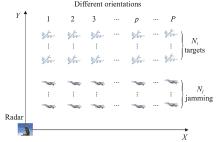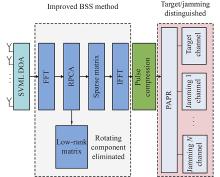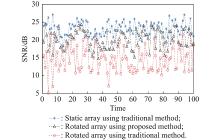| 1 |
DAI H Y, WANG X S, LI Y Z, et al Main-lobe jamming suppression method of using spatial polarization characteristics of antennas. IEEE Trans. on Aerospace and Electronic Systems, 2012, 48 (3): 2167- 2179.
doi: 10.1109/TAES.2012.6237586
|
| 2 |
LUO Z K, WANG H L, LV W H, et al Mainlobe anti-jamming via eigen-projection processing and covariance matrix reconstruction. ICE Trans. on Fundamentals of Electronics Communications and Computer Sciences, 2017, 100 (4): 1055- 1059.
|
| 3 |
CHEN X Z, SHU T, YU K B, et al Joint adaptive beamforming techniques for distributed array radars in multiple mainlobe and sidelobe jammings. IEEE Antennas and Wireless Propagation Letters, 2019, 19 (2): 248- 252.
|
| 4 |
SUN Q, ZHANG Q L, HUANG X Y, et al Target detection and localization method for distributed monopulse arrays in the presence of mainlobe jamming. Journal on Advances in Signal Processing, 2020, 2020, 1.
|
| 5 |
LUO S C, XIONG Y, CHENG H, et al An algorithm of radar deception jamming suppression based on blind signal separation. Proc. of the International Conference on Computational Problem-Solving, 2011, 167- 170.
|
| 6 |
LI M J, WANG N Main-lobe jamming cancellation for multistatic radar by joint range-Doppler processing. The Journal of Engineering, 2019, 20, 6807- 6810.
|
| 7 |
MENG M G, GUO L C Mainlobe jamming suppressing for distributed radar via joint blind source separation. IET Radar, Sonar & Navigation, 2019, 17 (3): 1189- 1199.
|
| 8 |
CHEN J, CHEN X L, ZHANG H G, et al Suppression method for main-lobe interrupted sampling repeater jamming in distributed radar. IEEE Access, 2020, 8, 139255- 139265.
doi: 10.1109/ACCESS.2020.3000278
|
| 9 |
WU Z J, WANG C X, JIANG P H, et al Range-Doppler sidelobe suppression for pulsed radar based on golay complementary codes. IEEE Signal Processing Letters, 2020, 27, 1205- 1209.
doi: 10.1109/LSP.2020.3007093
|
| 10 |
CHEN H, WANG Y L Interference jamming DOA estimation algorithm. Proc. of the IEEE Antennas and Propagation Society International Symposium, 2005, 358- 361.
|
| 11 |
LIU B Y, GUI G, MATSUSHITA S Y, et al. Anti-jamming DOA estimation based on compressive sensing via blocking matrix. Proc. of the IEEE 23rd International Conference on Digital Signal Processing, 2018. DOI: 10.1109/ICDSP.2018.8631577.
|
| 12 |
LIU B Y, GUI G, MATSUSHITA S Y, et al Compressive sensing based direction-of-arrival estimation in MIMO radars in presence of strong jamming via blocking matrix. Proc. of the IEEE 10th Sensor Array and Multichannel Signal Processing Workshop, 2018, 292- 296.
|
| 13 |
LI S Y, KE S, CHAI Y A time-domain combined anti-jamming preprocess method for DOA estimation in DSSS system. Proc. of the International Conference on Communications and Networking in China, 2017, 186- 194.
|
| 14 |
LEKHOVYTSKIY D I, ATAMANSKIY D V, RIABUKHA V P, et al. Combining target detection against the background of jamming signals and jamming signal DOA estimation. Proc. of the International Conference on Antenna Theory and Techniques, 2015. DOI: 10.1109/ICATT.2015.7136777.
|
| 15 |
LIU X L, LIAO G S Direction finding and mutual coupling estimation for bistatic MIMO radar. Signal Processing, 2012, 92 (2): 517- 522.
doi: 10.1016/j.sigpro.2011.08.017
|
| 16 |
CEDERVALL M, MOSES R L Efficient maximum likelihood DOA estimation for signals with known waveforms in the presence of multipath. IEEE Trans. on Signal Processing, 2008, 45 (3): 808- 811.
|
| 17 |
XIE W, WEN F, LIU J B, et al Source association, DOA, and fading coefficients estimation for multipath signals. IEEE Trans. on Signal Processing, 2017, 65 (11): 2773- 2786.
doi: 10.1109/TSP.2017.2669894
|
| 18 |
VISENTIN T, HASCH J, ZWICK T Analysis of multipath and DOA detection using a fully polarimetric automotive radar. International Journal of Microwave and Wireless Technologies, 2018, 10 (5/6): 570- 577.
|
| 19 |
RUSEK F, PERSSON D, LAU B K, et al. Scaling up MIMO: opportunities and challenges with very large arrays. IEEE Signal Processing Magazine, 2013, 30(1): 40−60.
|
| 20 |
KIM M, ICHIGE K, ARAI H Implementation of FPGA based fast unitary MUSIC DOA estimator. ICE Trans. on Electronics, 2004, 87 (9): 1485- 1494.
|
| 21 |
SONG W M, ZHANG J Y Research and FPGA implementation of MUSIC DOA of smart antenna array. Proc. of the International Conference on Networks Security, 2009, 189- 192.
|
| 22 |
JIAN C, WANG S X, LIN L. Two-dimensional DOA estimation of coherent signals based on 2D unitary exprint method. Proc. of the 8th International Conference on Signal Processing, 2006. DOI: 10.1109/ICOSP.2006.344524.
|
| 23 |
BENCHEIKH M L, WANG Y D Combined ESPRIT root-MUSIC for DOA-DOD estimation in polarimetric bistatic MIMO radar. Progress in Electromagnetics Research Letters, 2011, 22, 109- 117.
|
| 24 |
BENCHEIKH M L, WANG Y D Non circular ESPRIT-rootMUSIC joint DOA-DOD estimation in bistatic MIMO radar. Proc. of the International Workshop on Systems, Signal Processing and their Applications, 2011, 51- 54.
|
| 25 |
JABR K A, KWON H M, TAYEM N Modified UCA-ESPRINT for estimating DOA of coherent signals using one snapshot. Proc. of the IEEE Vehicular Technology Conference, 2008, 290- 293.
|
| 26 |
CAI X Z, SARABANDI K A fast analytic multiple-sources angle-of-arrival estimation algorithm for automotive MIMO radars. Proc. of the IEEE International Symposium on Antennas and Propagation and North American Radio Science Meeting, 2020, 1301- 1302.
|
| 27 |
ZHANG Q F, MA J, HUANG J G An information theoretic criterion for source number detection using the eigenvalues modified by gerschgorin radius. Proc. of the 5th IEEE Sensor Array and Multichannel Signal Processing Workshop, 2008, 400- 403.
|
| 28 |
GAO Z, CHEONG L F, WANG Y X Block-sparse RPCA for salient motion detection. IEEE Trans. on Pattern Analysis & Machine Intelligence, 2014, 36 (10): 1975- 1987.
|
| 29 |
KHALILIAN-GOURTANI A, MINAEE S, WANG Y. Masked-RPCA: moving object detection with an overlaying model. IEEE Open Journal of Signal Processing, 2020, 286(1): 274–286.
|
| 30 |
HAN S H, LEE J H An overview of peak-to-average power ratio reduction techniques for multicarrier transmission. IEEE Wireless Communications, 2005, 12 (2): 56- 65.
doi: 10.1109/MWC.2005.1421929
|
| 31 |
STOICA P, NEHORAI A Performance study of conditional and unconditional direction-of-arrival estimation. IEEE Trans. on Acoustics, Speech and Signal Processing, 1990, 38 (10): 1783- 1795.
doi: 10.1109/29.60109
|
| 32 |
HAO X, JIAN Z, JIE Q, et al RPCA-SVM fault diagnosis strategy of cascaded h-bridge multilevel inverters. Proc. of the International Conference on Green Energy, 2014, 164- 169.
|
 ), Gong ZHANG1,*(
), Gong ZHANG1,*( ), Biao XUE1(
), Biao XUE1( ), Jiawen YUAN1(
), Jiawen YUAN1( )
)







